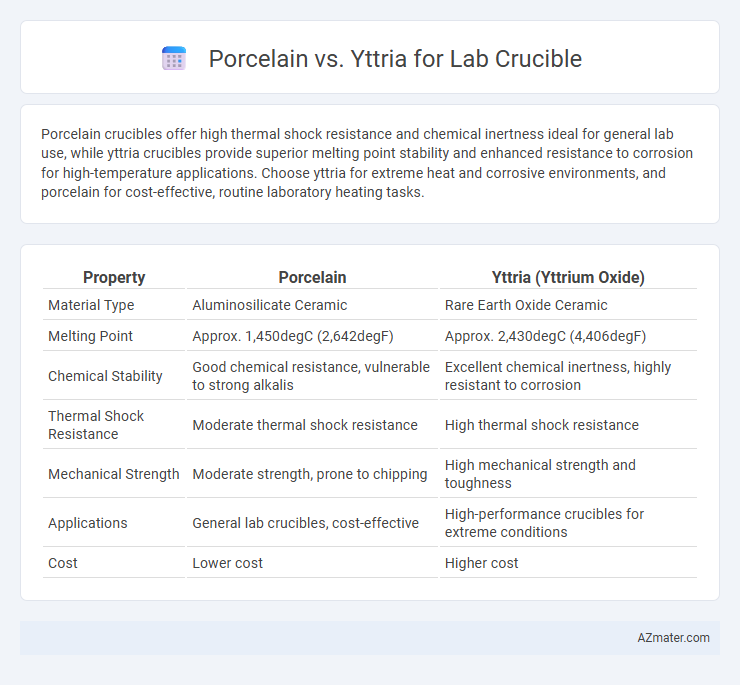Porcelain crucibles offer high thermal shock resistance and chemical inertness ideal for general lab use, while yttria crucibles provide superior melting point stability and enhanced resistance to corrosion for high-temperature applications. Choose yttria for extreme heat and corrosive environments, and porcelain for cost-effective, routine laboratory heating tasks.
Table of Comparison
| Property | Porcelain | Yttria (Yttrium Oxide) |
|---|---|---|
| Material Type | Aluminosilicate Ceramic | Rare Earth Oxide Ceramic |
| Melting Point | Approx. 1,450degC (2,642degF) | Approx. 2,430degC (4,406degF) |
| Chemical Stability | Good chemical resistance, vulnerable to strong alkalis | Excellent chemical inertness, highly resistant to corrosion |
| Thermal Shock Resistance | Moderate thermal shock resistance | High thermal shock resistance |
| Mechanical Strength | Moderate strength, prone to chipping | High mechanical strength and toughness |
| Applications | General lab crucibles, cost-effective | High-performance crucibles for extreme conditions |
| Cost | Lower cost | Higher cost |
Introduction to Lab Crucibles
Lab crucibles are essential containers used for heating chemical compounds to high temperatures during experiments. Porcelain crucibles offer excellent thermal shock resistance and chemical inertness, making them ideal for general laboratory use. Yttria crucibles provide superior corrosion resistance and higher melting points, suitable for specialized applications involving aggressive materials and extreme temperatures.
Overview of Porcelain Crucibles
Porcelain crucibles are widely used in laboratories due to their excellent thermal stability and chemical resistance, making them ideal for high-temperature applications and handling corrosive substances. Composed primarily of kaolin, feldspar, and quartz, porcelain offers a smooth, non-porous surface that prevents contamination and ensures precise thermal conductivity. Their durability and cost-effectiveness make porcelain crucibles a popular choice compared to yttria crucibles, which are typically reserved for specialized environments requiring extreme temperature resistance.
Overview of Yttria Crucibles
Yttria crucibles are highly valued in laboratory settings for their exceptional resistance to high temperatures and corrosion, making them ideal for melting and processing reactive metals. Composed primarily of yttrium oxide (Y2O3), these crucibles offer superior thermal stability and chemical inertness compared to porcelain, ensuring minimal contamination during experiments. Their durability and resistance to thermal shock make yttria crucibles a preferred choice for applications involving extreme heating cycles and aggressive reactive environments.
Material Properties Comparison
Porcelain crucibles offer excellent chemical inertness and thermal shock resistance, making them ideal for moderate temperature applications up to 1200degC. Yttria crucibles exhibit superior high-temperature stability, corrosion resistance, and can withstand temperatures exceeding 2000degC, suitable for advanced metallurgical processes. The choice between porcelain and yttria hinges on specific thermal requirements, chemical compatibility, and operational environment demands in laboratory settings.
Thermal Resistance and Stability
Porcelain lab crucibles exhibit moderate thermal resistance, typically withstanding temperatures up to 1,200degC, making them suitable for general laboratory heating tasks. Yttria crucibles, composed of yttrium oxide, offer superior thermal stability and resistance, withstanding temperatures exceeding 2,400degC, ideal for high-temperature, corrosive environments. The enhanced thermal shock resistance and chemical inertness of yttria crucibles outperform porcelain, ensuring greater durability and longevity in advanced industrial applications.
Chemical Compatibility and Reactivity
Porcelain lab crucibles exhibit excellent chemical compatibility with acids and bases, making them ideal for general laboratory use, but they can react with strong alkalis at high temperatures. Yttria crucibles, composed of yttrium oxide, offer superior chemical resistance against molten metals, slags, and aggressive chemicals, especially at elevated temperatures. Their high resistance to thermal shock and minimal reactivity with reactive substances make yttria crucibles the preferred choice for high-temperature applications requiring stringent chemical stability.
Durability and Lifespan
Yttria crucibles outperform porcelain in durability due to their superior resistance to thermal shock and chemical corrosion, making them ideal for high-temperature laboratory applications. Porcelain crucibles, while cost-effective and suitable for lower temperature uses, tend to have a shorter lifespan as they are more prone to cracking and structural degradation under intense heat cycles. The extended lifespan of yttria crucibles contributes to reduced replacement frequency and increased efficiency in rigorous lab environments.
Cost and Availability
Porcelain lab crucibles are generally more cost-effective and widely available due to their extensive use in standard laboratory settings. Yttria crucibles, made from yttrium oxide, tend to be significantly more expensive and less common, primarily used for specialized high-temperature or reactive applications. The choice between porcelain and yttria hinges on budget constraints and the specific thermal and chemical resistance requirements of the laboratory process.
Applications and Suitability
Porcelain lab crucibles are ideal for low to moderate temperature applications such as sample storage, ash melting, and chemical reactions involving acids due to their chemical inertness and thermal stability up to 1200degC. Yttria crucibles, made from yttrium oxide, are suitable for high-temperature processes exceeding 1800degC, including metal alloy melting, glass production, and ceramics sintering, thanks to their exceptional thermal shock resistance and corrosion resistance in molten metals. Selecting between porcelain and yttria crucibles depends on the specific thermal and chemical requirements of the laboratory application, with yttria offering superior durability for extreme conditions and porcelain providing cost-effective performance for general laboratory use.
Choosing the Right Crucible for Your Needs
Porcelain crucibles offer excellent chemical resistance and thermal stability, making them ideal for general laboratory use involving moderate temperatures and corrosive substances. Yttria crucibles, made from yttrium oxide, provide superior resistance to high temperatures and aggressive molten metals, suitable for specialized high-temperature processes and metallurgical applications. Selecting the right crucible depends on factors like maximum temperature, chemical compatibility, and specific laboratory procedures to ensure durability and accurate results.

Infographic: Porcelain vs Yttria for Lab Crucible
 azmater.com
azmater.com